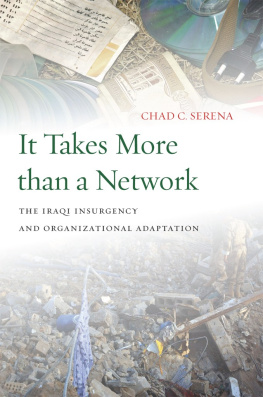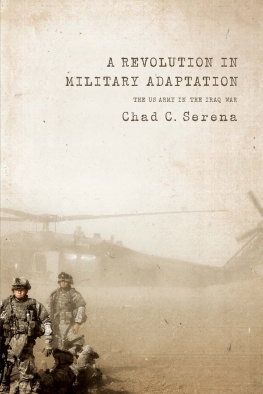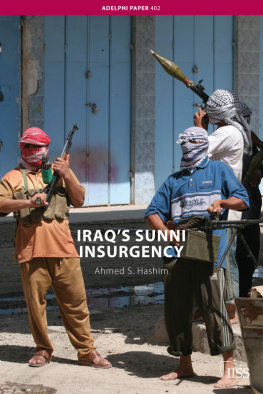Stanford University Press
Stanford, California
2014 by the Board of Trustees of the Leland Stanford Junior University.
All rights reserved.
The views expressed here are those solely of the author and do not reflect the views or opinions of the RAND Corporation or its sponsors.
No part of this book may be reproduced or transmitted in any form or by any means, electronic or mechanical, including photocopying and recording, or in any information storage or retrieval system without the prior written permission of Stanford University Press.
Printed in the United States of America on acid-free, archival-quality paper
Library of Congress Cataloging-in-Publication Data
Serena, Chad C., author
It takes more than a network : the Iraqi insurgency and organizational adaptation / Chad C. Serena.
pages cm.
Includes bibliographical references and index.
ISBN 978-0-8047-8903-5 (cloth : alk. paper) ISBN 978-0-8047-9045-1 (pbk : alk. paper)
1. InsurgencyIraq. 2. Iraq War, 20032011. 3. Organizational changeIraq. 4. Organizational effectivenessIraq. 5. InsurgencyAfghanistan. 6. Afghan War, 2001. I. Title.
DS79.76.S457 2014
956.7044'3dc23
2013043449
ISBN 978-0-8047-9046-8 (electronic)
Typeset at Stanford University Press in 10/14 Minion
Special discounts for bulk quantities of Stanford Security Studies are available to corporations, professional associations, and other organizations. For details and discount information, contact the special sales department of Stanford University Press. Tel: (650) 736-1782, Fax: (650) 736-1784
It Takes More than a Network
The Iraqi Insurgency and Organizational Adaptation
Chad C. Serena
Stanford Security Studies
An Imprint of Stanford University Press
Stanford, California
Contents
Acknowledgments
I owe a debt of gratitude to a number of friends and colleagues for their support and assistance; without their stewardship, efforts, and counsel, this book would not have been possible.
At the University of Pittsburgh, I am indebted to Phil Williams for his continued willingness to advise and assist me. I would also like to thank Dennis Gormley, Donald Goldstein, and Michael Brenner for their friendship and support.
At the RAND Corporation, I would like to thank my friend and colleague Colin Clarke for taking the time to review my work in detail, for availing his expertise, and for providing steady counsel.
At the U.S. Army War College, I would like to thank Steve Metz for his friendship and guidance. It was at his suggestion that I further developed the central thesis of this book. He was also largely responsible for putting me into contact with many of the people that I interviewed or had discussions with while researching this book.
I would especially like to acknowledge the many named and unnamed veterans of the U.S. Army who selflessly took the time to inform me with their experience and expertise. In particular, I would like to thank General (Ret.) Peter W. Chiarelli, Lieutenant General Daniel Bolger, Lieutenant General David Perkins, Major General H. R. McMaster, Colonel James Crider, and Colonel (Ret.) Peter Mansoor. These discussions helped to refine my thoughts and provided the appropriate context for my understanding of the subject of this book.
At Stanford University Press, I would like to thank Geoffrey Burn and James Holt for their editorial support and advice. I would also like to acknowledge and thank my reviewers: their comments and contributions helped to make this a better book.
Most important, I would like to thank my family for always being there to provide me with support, especially my wife, Mia. Words cannot express how much she means to me.
Acronyms and Abbreviations
| AAR | After Action Review |
| AQI | al Qaeda in Iraq |
| ASU | Active Service Unit |
| C4ISR | Command, Control, Communications, Computers, Intelligence, Surveillance, and Reconnaissance |
| COMINT | Communications Intelligence |
| DOD | Department of Defense |
| ETIM | Eastern Turkestan Islamic Movement |
| EFP | Explosively Formed Penetrators (and Projectiles) |
| EW | Electronic Warfare |
| FATA | Federally Administered Tribal Areas |
| FOB | Forward Operating Base |
| FRE | Former Regime Elements |
| HiG | Hizb-i-Islami Gulbuddin |
| HUMINT | Human Intelligence |
| IEA | Islamic Emirate of Afghanistan |
| IED | Improvised Explosive Device |
| IMU | Islamic Movement of Uzbekistan |
| INP | Iraqi National Police |
| IR | Infra-red |
| IRGC | Islamic Revolutionary Guard Corps |
| ISF | Iraqi Security Forces |
| ISI | Inter-Services Intelligence |
| IT | Information Technology |
| JAM | Jaish al Mahdi |
| JIEDDO | Joint Improvised Explosive Device Defeat Organization |
| LeT | Lashkar-e Taiba |
| MDMP | Military Decision Making Process |
| MSC | Mujahideen Shura Council |
| MTT | Mobile Training Team |
| NCTC | National Counterterrorism Center |
| NGO | Non-Governmental Organization |
| PDF | Portable Document Format |
| PIRA | Provisional Irish Republican Army |
| ROE | Rules of Engagement |
| RPG | Rocket Propelled Grenade |
| SGC | Special Group Criminals |
| SIGINT | Signals Intelligence |
| SOP | Standing Operating Procedure |
| STX | Squad Training Exercise |
| SVBIED | Suicide Vehicle Borne Improvised Explosive Device |
| TNSM | Tehreek-e-Nafaz-e-Shariat-e-Mohammadi |
| TTP | Tehreek-e Taliban (Pakistan) |
| UAV | Unmanned Aerial Vehicle |
Introduction
Between 2003 and 2008, there were no fewer than ninety named insurgent organizations in Iraq engaged in a struggle against the U.S.-led Coalition and a nascent Iraqi government. Many of these attacks were conducted against Coalition forces but many were also conducted against the Iraqi National Police (INP), the Iraqi Army, and Iraqi businessmen, educators, store owners, politicians, and civilians.
The actual size of the Iraqi insurgency is difficult to estimate.bership is used, then it may have had, potentially, 200,000 (minimum) to 2.7 million (maximum) underground supporters. These are quite large numbers in a country that currently has a population of roughly 30 million.
The Iraqi insurgency was unquestionably large and complex in terms of membership and composition. Adding to its complexity was its networked structure, disposition, and operations. Insurgent organizations operated on local, provincial, or regional levels. They were linked by shared membership, associations, familial ties, tribal affiliations, religion, ideology, needs, transaction structures, and the overarching goal of ridding Iraq of the U.S.-led Coalition and the government that the Coalition helped establish. These shared interests and the compelling goal of ousting what many viewed as a hostile occupying force were the unifying factors that both compelled the insurgency and gave it a measure of coherence. Few if any insurgent organizations had the capacity to conduct operations across the whole of Iraq, and none had the ability to coordinate operations countrywide on anything other than a very temporary basis. Nonetheless, the insurgency engulfed the Iraqi state: not as a structured whole but instead as a loose and shifting mosaic of small- and medium-size organizations sharing a mutual and broader interest. This phenomenon, although not sui generis or entirely new, had not been seen on this scale in previous insurgencies.












